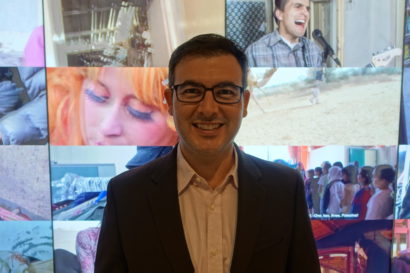This article by Kathleen McClay was originally published in the Berkeley News on Nov 29th, 2017.

The Global Lives Project is a video library with no voice-overs or narratives, just 24 continuous hours in the lives of people around the world. (Photo courtesy of the Global Lives Project)
While an undergraduate at UC Berkeley in 2002, David Harris came up with the idea to record a day in an ordinary person’s life and share their specialness. After graduating two years later, he recorded 24 hours with James Bullock, a cable car operator on the California Street line in San Francisco, in an effort to share the specialness of an ordinary person.
Almost 15 years later, the Global Lives Project launched by Harris includes 20 videos of individuals from every corner of the world, ranging from a college student in Tokyo and a traveling clown in Spain, to a Vietnamese sand barge worker and a train attendant in China as they go about 24 consecutive hours in their lives. Future packages, he said, may center on climate change or the global disability community, or ideas he has yet to conceive.
Our place in the world
“Global Lives challenges audiences to reflect deeply about their place in the world and the moral and ethical responsibilities that come with that,” said Harris.
Now a chancellor’s public scholar and lecturer at the Berkeley-Haas School of Business who is teaching courses on social movements, social media and “futures thinking,” Harris will discuss Global Lives film clips at 2 p.m. on Sunday, Dec. 3, at BAMPFA. Joining him will be his longtime project collaborators, filmmakers Naomi Ture and Daniel Chein and web developer/Buddhist priest Ben Meyers/Shishin Junsei.
Campus programming
Global Lives Project videos filmed in Brazil, Japan, India, South Korea, Nepal, Turkey, Spain, Serbia, China, Malawi, Indonesia, Vietnam, Canada and the United States, are part of the 2017-2018 academic year programming at several campus venues that reflect the project’s multidisciplinary roots and message.
Exhibition sites include BAMPFA (which is showing clips in a mini-retrospective through Dec. 29), the Center for Information Technology Research in the Interest of Society (CITRIS) and the Banatao Institute Tech Museum through May 2018, in the entryway of the Phoebe A. Hearst Museum of Anthropology through 2018, and at the Center for Social Sector Leadership at the Berkeley-Haas Chou Hall in spring 2018.
Chein, the Oakland-based filmmaker and trained anthropologist, said each venue highlights a different piece of the project.
“It makes sense for us to be able to emphasize more of an anthropological component at the Hearst Museum, and the technological aspects at CITRIS and the art side at BAMPFA,” he said.
A freshman seminar’s imprint
In a freshman seminar about the arts at UC Berkeley that was taught by now UC Berkeley Chancellor Carol Christ almost 20 years ago, Harris said he realized that he didn’t “need to be bound by the boundaries of my discipline,” which turned out to be a mix of political economy and international development, with sociology and a little forestry thrown in.
A couple of years later, that point was underscored by Harris’s participation in a two-semester Study Abroad program that placed him with families in the United Kingdom, Tanzania, Mexico City, the Philippines and India.
“The program changed my life. It changed everything in me,” he recalled. “I wanted to share this newfound sense of the importance of understanding cultures and lives from beyond my local community.”
At a time before everyone had the option of recording video from the cell phone in their pocket, Harris had to borrow a video camera from Shawn Brixey, then a UC Berkeley professor of art practice, as well as the founder and director of the Center for Digital Art and New Media Research (now the Berkeley Center for New Media). Harris had been introduced to Brixey’s new media work in the freshman seminar.
Harris set out to record the pilot video with James, the cable car operator introduced to him by a friend. Today, he’s still at it, and continues to shun early advice to hone in exciting and quirky characters and favors the ordinary people that viewers can more easily relate to.
All in all, he said, the Global Lives Project “aligns closely with UC Berkeley’s commitment to intellectual inquiry and global perspective.”
Uncommon transparency
And in much the way that he was nurtured as an undergraduate in that seminar course, Harris is introducing young students to his project via UC Berkeley’s American Cultures Engaged Scholarship program (ACES) and Undergraduate Research Apprenticeship Program (URAP).
Kristy Drutman continued with the project after a URAP stint, working most recently as the Global Lives’ social media coordinator and previously putting subtitles on the films that required watching repeatedly.
“I really had to challenge myself about how I understand others,” she said. “I had to get away from putting them in my box and understanding them through my Western lens.”
Chein said the 24-hour segments contain an uncommon transparency that lets viewers “step back and reflect on the larger world around them, by seeing people from all walks of life.”
Global Lives funding has come from the Adobe and Smithsonian foundations, the National Endowment for the Arts, and the Berkeley-Haas’ Eckles Fund for Diversity and Social Impact, among others.
The project also has branched out to produce Unheard Stories, a 58-page curriculum and educator guide, to teach the principles of empathy, compassion and global citizenship to middle- and high-school students.




